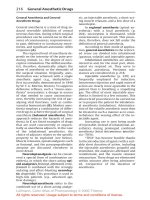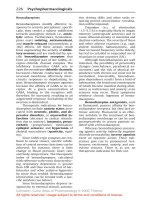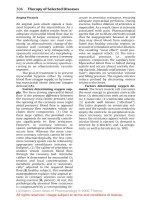Color Atlas of Pharmacology (Part 21): Psychopharmacologicals
Bạn đang xem bản rút gọn của tài liệu. Xem và tải ngay bản đầy đủ của tài liệu tại đây (510.23 KB, 16 trang )
Benzodiazepines
Benzodiazepines modify affective re-
sponses to sensory perceptions; specifi-
cally, they render a subject indifferent
towards anxiogenic stimuli, i.e., anxio-
lytic action. Furthermore, benzodiaze-
pines exert sedating, anticonvulsant,
and muscle-relaxant (myotonolytic, p.
182) effects. All these actions result
from augmenting the activity of inhibi-
tory neurons and are mediated by spe-
cific benzodiazepine receptors that
form an integral part of the GABA
A
re-
ceptor-chloride channel complex. The
inhibitory transmitter GABA acts to
open the membrane chloride channels.
Increased chloride conductance of the
neuronal membrane effectively short-
circuits responses to depolarizing in-
puts. Benzodiazepine receptor agonists
increase the affinity of GABA to its re-
ceptor. At a given concentration of
GABA, binding to the receptors will,
therefore, be increased, resulting in an
augmented response. Excitability of the
neurons is diminished.
Therapeutic indications for benzo-
diazepines include anxiety states asso-
ciated with neurotic, phobic, and de-
pressive disorders, or myocardial in-
farction (decrease in cardiac stimula-
tion due to anxiety); insomnia; prean-
esthetic (preoperative) medication;
epileptic seizures; and hypertonia of
skeletal musculature (spasticity, rigid-
ity).
Since GABA-ergic synapses are con-
fined to neural tissues, specific inhibi-
tion of central nervous functions can be
achieved; for instance, there is little
change in blood pressure, heart rate,
and body temperature. The therapeutic
index of benzodiazepines, calculated
with reference to the toxic dose produc-
ing respiratory depression, is greater
than 100 and thus exceeds that of bar-
biturates and other sedative-hypnotics
by more than tenfold. Benzodiazepine
intoxication can be treated with a spe-
cific antidote (see below).
Since benzodiazepines depress re-
sponsivity to external stimuli, automo-
tive driving skills and other tasks re-
quiring precise sensorimotor coordina-
tion will be impaired.
Triazolam (t
1/2
of elimination
~1.5–5.5 h) is especially likely to impair
memory (anterograde amnesia) and to
cause rebound anxiety or insomnia and
daytime confusion. The severity of these
and other adverse reactions (e.g., rage,
violent hostility, hallucinations), and
their increased frequency in the elderly,
has led to curtailed or suspended use of
triazolam in some countries (UK).
Although benzodiazepines are well
tolerated, the possibility of personality
changes (nonchalance, paradoxical ex-
citement) and the risk of physical de-
pendence with chronic use must not be
overlooked. Conceivably, benzodiaze-
pine dependence results from a kind of
habituation, the functional counterparts
of which become manifest during absti-
nence as restlessness and anxiety; even
seizures may occur. These symptoms
reinforce chronic ingestion of benzo-
diazepines.
Benzodiazepine antagonists, such
as flumazenil, possess affinity for ben-
zodiazepine receptors, but they lack in-
trinsic activity. Flumazenil is an effec-
tive antidote in the treatment of ben-
zodiazepine overdosage or can be used
postoperatively to arouse patients se-
dated with a benzodiazepine.
Whereas benzodiazepines possess-
ing agonist activity indirectly augment
chloride permeability, inverse agonists
exert an opposite action. These sub-
stances give rise to pronounced rest-
lessness, excitement, anxiety, and con-
vulsive seizures. There is, as yet, no
therapeutic indication for their use.
226 Psychopharmacologicals
Lüllmann, Color Atlas of Pharmacology © 2000 Thieme
All rights reserved. Usage subject to terms and conditions of license.
Psychopharmacologicals 227
A. Action of benzodiazepines
Anxiolysis
plus anticonvulsant effect,
sedation, muscle relaxation
Diazepam
R
1
= Cl
R
2
= CH
3
R
3
= R
4
= H
Benzo
diaz
epine
R
4
N
N
R
1
R
3
O
R
2
Inhibition of
excitation
Hyper-
polari-
zation
GABA
GABA-gated Cl
-
-channel
Cl
-
Benzodiazepines
Unopposed excitation
Normal
GABA-ergic inhibition
Enhanced
GABA-ergic inhibition
GABA-ergic neuron
Benzodiazepine
receptor
GABA-receptor
Chloride
ionophore
GABA=
!-amino-
butryc acid
Lüllmann, Color Atlas of Pharmacology © 2000 Thieme
All rights reserved. Usage subject to terms and conditions of license.
Pharmacokinetics of Benzodiazepines
All benzodiazepines exert their actions
at specific receptors (p. 226). The choice
between different agents is dictated by
their speed, intensity, and duration of
action. These, in turn, reflect physico-
chemical and pharmacokinetic proper-
ties. Individual benzodiazepines remain
in the body for very different lengths of
time and are chiefly eliminated through
biotransformation. Inactivation may en-
tail a single chemical reaction or several
steps (e.g., diazepam) before an inactive
metabolite suitable for renal elimina-
tion is formed. Since the intermediary
products may, in part, be pharmacologi-
cally active and, in part, be excreted
more slowly than the parent substance,
metabolites will accumulate with con-
tinued regular dosing and contribute
significantly to the final effect.
Biotransformation begins either at
substituents on the diazepine ring (diaz-
epam: N-dealkylation at position 1;
midazolam: hydroxylation of the methyl
group on the imidazole ring) or at the
diazepine ring itself. Hydroxylated mid-
azolam is quickly eliminated following
glucuronidation (t
1/2
~ 2 h). N-de-
methyldiazepam (nordazepam) is bio-
logically active and undergoes hydroxy-
lation at position 3 on the diazepine
ring. The hydroxylated product (oxaze-
pam) again is pharmacologically active.
By virtue of their long half-lives, diaze-
pam (t
1/2
~ 32 h) and, still more so, its
metabolite, nordazepam (t
1/2
50–90 h),
are eliminated slowly and accumulate
during repeated intake. Oxazepam
undergoes conjugation to glucuronic ac-
id via its hydroxyl group (t
1/2
= 8 h) and
renal excretion (A).
The range of elimination half-lives
for different benzodiazepines or their
active metabolites is represented by the
shaded areas (B). Substances with a
short half-life that are not converted to
active metabolites can be used for in-
duction or maintenance of sleep (light
blue area in B). Substances with a long
half-life are preferable for long-term
anxiolytic treatment (light green area)
because they permit maintenance of
steady plasma levels with single daily
dosing. Midazolam enjoys use by the i.v.
route in preanesthetic medication and
anesthetic combination regimens.
Benzodiazepine Dependence
Prolonged regular use of benzodiaze-
pines can lead to physical dependence.
With the long-acting substances mar-
keted initially, this problem was less ob-
vious in comparison with other depen-
dence-producing drugs because of the
delayed appearance of withdrawal
symptoms. The severity of the absti-
nence syndrome is inversely related to
the elimination t
1/2
, ranging from mild
to moderate (restlessness, irritability,
sensitivity to sound and light, insomnia,
and tremulousness) to dramatic (de-
pression, panic, delirium, grand mal sei-
zures). Some of these symptoms pose
diagnostic difficulties, being indistin-
guishable from the ones originally treat-
ed. Administration of a benzodiazepine
antagonist would abruptly provoke ab-
stinence signs. There are indications
that substances with intermediate elim-
ination half-lives are most frequently
abused (violet area in B).
228 Psychopharmacologicals
Lüllmann, Color Atlas of Pharmacology © 2000 Thieme
All rights reserved. Usage subject to terms and conditions of license.
Psychopharmacologicals 229
B. Rate of elimination of benzodiazepines
A. Biotransformation of benzodiazepines
Midazolam Diazepam
as glucuronide
Active metabolites
Inactive
Oxazepam
Nordazepam
Triazolam
Brotizolam
Oxazepam
Lormetazepam
Bromazepam
Flunitrazepam
Lorazepam
Camazepam
Nitrazepam
Clonazepam
Diazepam
Temazepam
Prazepam
Applied drug Active metabolite
Plasma elimination half-life
Hypnagogic
effect
Abuse
liability
Anxiolytic effect
0 20 30 40 50 6010 >60 h
Lüllmann, Color Atlas of Pharmacology © 2000 Thieme
All rights reserved. Usage subject to terms and conditions of license.
Therapy of Manic-Depressive Illness
Manic-depressive illness connotes a
psychotic disorder of affect that occurs
episodically without external cause. In
endogenous depression (melancholia),
mood is persistently low. Mania refers
to the opposite condition (p. 234). Pa-
tients may oscillate between these two
extremes with interludes of normal
mood. Depending on the type of disor-
der, mood swings may alternate
between the two directions (bipolar de-
pression, cyclothymia) or occur in only
one direction (unipolar depression).
I. Endogenous Depression
In this condition, the patient experienc-
es profound misery (beyond the
observer’s empathy) and feelings of se-
vere guilt because of imaginary miscon-
duct. The drive to act or move is inhibit-
ed. In addition, there are disturbances
mostly of a somatic nature (insomnia,
loss of appetite, constipation, palpita-
tions, loss of libido, impotence, etc.). Al-
though the patient may have suicidal
thoughts, psychomotor retardation pre-
vents suicidal impulses from being car-
ried out. In A, endogenous depression is
illustrated by the layers of somber col-
ors; psychomotor drive, symbolized by
a sine oscillation, is strongly reduced.
Therapeutic agents fall into two
groups:
¼
Thymoleptics, possessing a pro-
nounced ability to re-elevate de-
pressed mood e.g., the tricyclic anti-
depressants;
¼
Thymeretics, having a predominant
activating effect on psychomotor
drive, e g., monoamine oxidase inhib-
itors.
It would be wrong to administer
drive-enhancing drugs, such as amphet-
amines, to a patient with endogenous
depression. Because this therapy fails to
elevate mood but removes psychomo-
tor inhibition (A), the danger of suicide
increases.
Tricyclic antidepressants (TCA;
prototype: imipramine) have had the
longest and most extensive therapeutic
use; however, in the past decade, they
have been increasingly superseded by
the serotonin-selective reuptake inhibi-
tors (SSRI; prototype: fluoxetine).
The central seven-membered ring
of the TCAs imposes a 120° angle
between the two flanking aromatic
rings, in contradistinction to the flat
ring system present in phenothiazine
type neuroleptics (p. 237). The side
chain nitrogen is predominantly proto-
nated at physiological pH.
The TCAs have affinity for both re-
ceptors and transporters of monoamine
transmitters and behave as antagonists
in both respects. Thus, the neuronal re-
uptake of norepinephrine (p. 82) and se-
rotonin (p. 116) is inhibited, with a re-
sultant increase in activity. Muscarinic
acetylcholine receptors, !-adrenocep-
tors, and certain 5-HT and hista-
mine(H
1
) receptors are blocked. Inter-
ference with the dopamine system is
relatively minor.
How interference with these trans-
mitter/modulator substances translates
into an antidepressant effect is still hy-
pothetical. The clinical effect emerges
only after prolonged intake, i.e., 2–3 wk,
as evidenced by an elevation of mood
and drive. However, the alteration in
monoamine metabolism occurs as soon
as therapy is started. Conceivably, adap-
tive processes (such as downregulation
of cortical serotonin and "-adrenocep-
tors) are ultimately responsible. In
healthy subjects, the TCAs do not im-
prove mood (no euphoria).
Apart from the antidepressant ef-
fect, acute effects occur that are evident
also in healthy individuals. These vary
in degree among individual substances
and thus provide a rationale for differ-
entiated clinical use (p. 233), based
upon the divergent patterns of interfer-
ence with amine transmitters/modula-
tors. Amitriptyline exerts anxiolytic,
sedative and psychomotor dampening
effects. These are useful in depressive
patients who are anxious and agitated.
In contrast, desipramine produces
psychomotor activation. Imipramine
230 Psychopharmacologicals
Lüllmann, Color Atlas of Pharmacology © 2000 Thieme
All rights reserved. Usage subject to terms and conditions of license.
Psychopharmacologicals 231
A. Effect of antidepressants
Amphetamine Immediate
Week 9
Week 7 Week 5
Week 3
Endogenous
depression
Imipramine
5HT
or
NA
Inhibition of
re-uptake
Deficient drive
Normal
mood
Normal drive
M, H
1
, !
1
Blockade of
receptors
Ach
NA
Effects on synaptic transmission
by inhibition of amine re-uptake
and by receptor antagonism
Lüllmann, Color Atlas of Pharmacology © 2000 Thieme
All rights reserved. Usage subject to terms and conditions of license.









